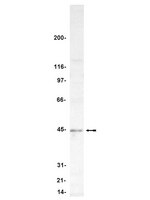Single-pot enzymatic synthesis of Dicer-substrate siRNAs.
Guiley, KZ; Pratt, AJ; MacRae, IJ
Nucleic acids research
40
e40
2011
Show Abstract
We describe an inexpensive and efficient method for generating functional pools of Dicer-substrate small interfering RNAs (siRNAs) in a single reaction tube. The method exploits a highly active form of the enzyme Dicer from Giardia lamblia, which is capable of accurately processing double-stranded RNA (dsRNA) into 25-27 nt RNA pools during in vitro transcription. The small RNAs produced function as substrates of human Dicer in vitro and induce gene silencing with potency equivalent to traditional siRNAs when introduced into mammalian cells. The overall reaction is simple, can be carried out in any laboratory with access to a PCR machine, and is amenable to high-throughput processes. | Western Blotting | 22189103
 |
A protein phosphatase methylesterase (PME-1) is one of several novel proteins stably associating with two inactive mutants of protein phosphatase 2A.
Ogris, E, et al.
J. Biol. Chem., 274: 14382-91 (1999)
1998
Show Abstract
Carboxymethylation of proteins is a highly conserved means of regulation in eukaryotic cells. The protein phosphatase 2A (PP2A) catalytic (C) subunit is reversibly methylated at its carboxyl terminus by specific methyltransferase and methylesterase enzymes which have been purified, but not cloned. Carboxymethylation affects PP2A activity and varies during the cell cycle. Here, we report that substitution of glutamine for either of two putative active site histidines in the PP2A C subunit results in inactivation of PP2A and formation of stable complexes between PP2A and several cellular proteins. One of these cellular proteins, herein named protein phosphatase methylesterase-1 (PME-1), was purified and microsequenced, and its cDNA was cloned. PME-1 is conserved from yeast to human and contains a motif found in lipases having a catalytic triad-activated serine as their active site nucleophile. Bacterially expressed PME-1 demethylated PP2A C subunit in vitro, and okadaic acid, a known inhibitor of the PP2A methylesterase, inhibited this reaction. To our knowledge, PME-1 represents the first mammalian protein methylesterase to be cloned. Several lines of evidence indicate that, although there appears to be a role for C subunit carboxyl-terminal amino acids in PME-1 binding, amino acids other than those at the extreme carboxyl terminus of the C subunit also play an important role in PME-1 binding to a catalytically inactive mutant. | | 10318862
 |









